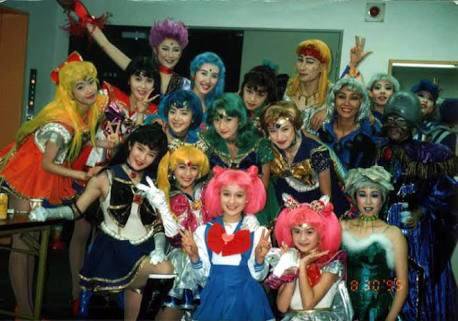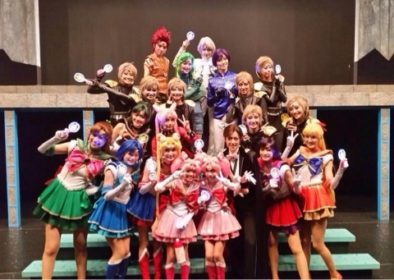And by “two Sailor ChibiMoons,” of course I mean “two actresses playing the role of a single Sailor ChibiMoon, because having two Sailor ChibiMoons in the same musical would be ridiculous.” But since writing a good, concise title is such a challenge, I suppose we’ll have to deal with a little ambiguity.
Title issues aside, this is actually a question that’s been bothering me for quite some time now. While the young actresses taking on the role of ChibiUsa were generally pretty young, they were never quite young enough that it would have been a Full House-style situation and that the actresses simply weren’t able to remember all of their lines, right?
Figuring that there has to be something much deeper going on here, I finally decided that it was about time to dive head first into this mystery to solve the riddle of the dual rabbits.
I hope you join along, because this is bound to make for an interesting ride!
As I mentioned earlier, my first gut-instinct was that this was simply related to the difficulty of performing on stage. After all, Hollywood has a long-standing tradition of giving a single role to twins (or similar looking children)1 if the actor or actress is deemed too young to reliably perform all of their scenes. And hey, Sailor Moon is full of twins as it is, so it’d even work out okay if they appeared in the same place!
Unfortunately, this theory kind of fell apart when I learned that the twin rabbits didn’t actually perform together.
That’s right. Much to my surprise, the two ChibiUsa’s didn’t usuallt act in the same performance together, but would each play their role in their own respective musical performances.2
The exact mechanism for how this was done was different for each musical production, but they were either divided up on a per-day basis, or they would split the day and night performances between the two actresses. Audiences would come to the venue on the day of the performance and there would be a signboard out front, telling them who “Today’s ChibiUsa” would be.
Hmm, if it’s not related to the young actresses’ ability to perform their roles, then what is it?
The next obvious choice is Japanese child labor laws, because if there’s anything Japan is known for, it’s having a deep-seated desire to respect the rights of workers.3
So what does Japanese law say about child labor?
Well, generally children under the age of 13 are prohibited from working, and even when they are allowed to work, it’s only in certain pre-approved job categories that involve minimal labor until the age of 15.4 But, as we all know, for every rule there is the exception.
In the case of child performers, there is an exemption that allows them to work even when younger than 13, provided that their performing will not affect their schooling. As outlined in the Japanese Labor Standards Act :5
With respect to a child employed pursuant to paragraph (2) of the preceding Article, the Employer shall keep at the workplace a certificate issued by the head of that child’s school certifying that the employment does not hinder the child’s attendance at school, and written consent from the person who has parental authority for, or is the legal guardian of, the child.
So what we’re basically saying here is that a child may only act or otherwise work in a production if the principal of their school certifies that the work they’re performing won’t negatively impact their schooling, and their parent/guardian has given their consent.
Considering that each of the musicals are only ~2 hours long or so, it can’t be all that huge of a disruption to play all the performances, right?
Alas, when we’re talking about matters that involve the law, absolutely nothing is as simple as it seems. You see, the law goes on to explain:6
With respect to the application of the provisions of Article 32 to children employed pursuant to paragraph (2) of Article 56, the phrase “40 hours per week” in paragraph (1) of Article 32 shall be read as “40 hours per week including school hours,” and the phrase “8 hours per day” in paragraph (2) of Article 32 shall be read as “7 hours per day including school hours.”
For those that don’t spend their days reading up on Japanese laws,7 what this essentially says is that children under the age of 13 hired to work in the entertainment industry are only allowed to work seven hours a day, however, both school hours and and working hours count toward that same limit. The same applies on a weekly basis, with a cumulative total schooling and working hours limited to 40 per week.
And in case you’re curious, practice sessions and even time for changing into and out of your costume also count against that total.8
When you look at it in that light, you can definitely see how it could make sense to just have two actresses perform the role, rather than micromanaging schedules.
Though the restrictions put on child performers are imposed under the Labor Standards Act, it’s interesting to see that the reason for these protections generally have nothing to do with concern for overworking the children, but rather for ensuring that they’re receiving a proper education. This is still a noble goal, of course, but definitely not the result I would have expected.
One question left unsolved for me, though, is why there weren’t always multiple actresses playing ChibiUsa. Since the laws were pretty strict, and in most cases the young performers playing the role were under the age of 13, you’d figure that it’d make sense, right? My best guess is that maybe some of the musicals held fewer performances per week, thus allowing then to work around the restriction. But I have no way of confirming that If you know where to find more detailed SeraMyu performance information, I’d love to check it out!
References:
- See 15 Roles You Never Knew Were Played By Twins ↩
- See Today’s ChibiUsa ↩
- In case you’re not totally sure, this is obviously sarcasm. I mean, we’re talking about the country that invented a term for dying from working too hard; see Karoshi (Wikipedia) ↩
- See Article 56 of the Labor Standards Act ↩
- See Article 57(2) of the Labor Standards Act ↩
- See Article 60(2) of the Labor Standards Act ↩
- And you really should be thankful for this… trust me ↩
- See Laws Concerning Child Labor ↩





This is not uniquely Japanese but applicable worldwide. For example, the Matilda musical featured three or even four child actresses in the titular role. In general, laws surrounding child performers have been tightening around the world; governments increasingly realize that parents of child performers may be in conflict in interest, so state intervention is necessary to protect the children.
I hear this is also common in the musical Annie. I wasn’t able to confirm it, but apparently that was the first musical to introduce the concept of “double casting” to Japan.
I always wonder how fans feel when they buy the DVD/VHS of the SeraMyu and the recorded version doesn’t contain their favorite ChibiMoon. I doubt many people really care that much, but it’s definitely a possible point of conflict!
I assumed it was something like this. It’s a similar reason for why Olsen twins played the same role in Full House, and twins have been used for other similar situations as well. Still, it’s not like all the child roles had to be played by two people… obviously there are differences between TV and a live performance in a costume though, and different laws.
So what about the other actresses that were under 13 such as Marina Kuroki who stared playing Sailor Moon at age 12? 😕
Looks like she started playing from the Summer 2001 season, when she was 12, and then would have turned 13 in September of that year.
Maybe they just kept performances to a minimum?
I also haven’t looked into it, but the ~1 month summer break may also be taken into account since there wouldn’t have been any schooling during that time.